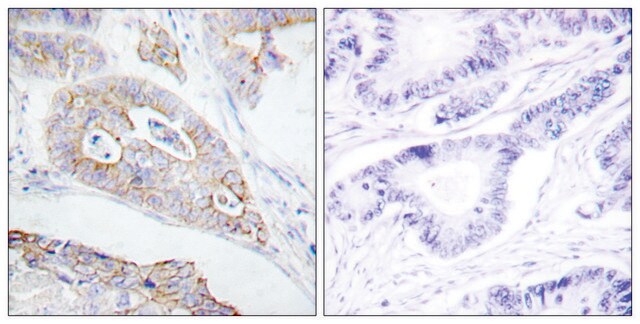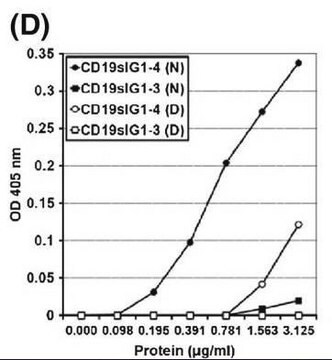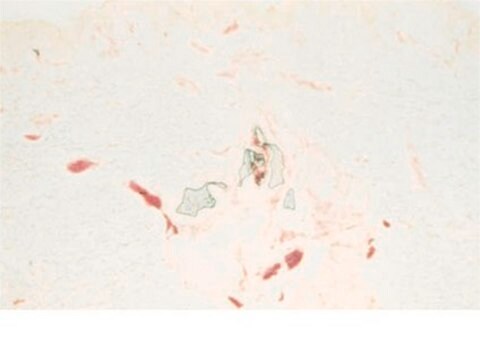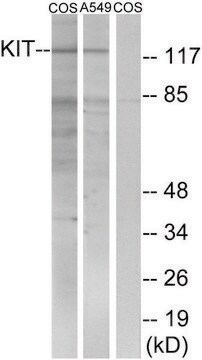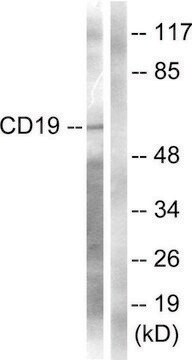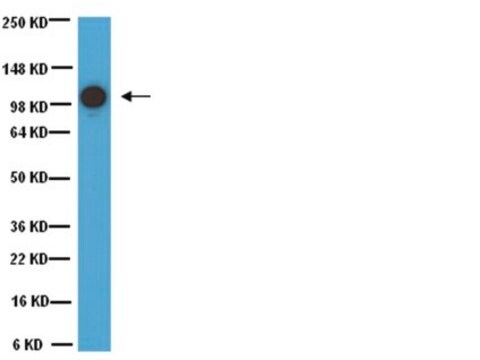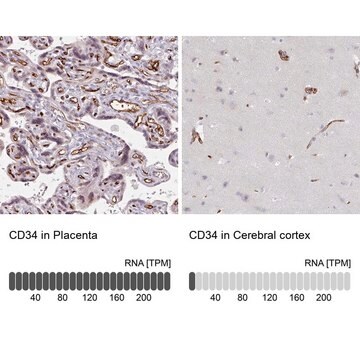추천 제품
생물학적 소스
mouse
Quality Level
항체 형태
ascites fluid
항체 생산 유형
primary antibodies
클론
STRO-1, monoclonal
종 반응성
human, primate
제조업체/상표
Chemicon®
기술
flow cytometry: suitable
immunofluorescence: suitable
입력
sample type mesenchymal stem cell(s)
동형
IgM
배송 상태
dry ice
타겟 번역 후 변형
unmodified
일반 설명
STRO-1 is a cell surface protein expressed by bone marrow stromal cells and erythroid precursors. The frequency of colony forming units fibroblasts (CFU-F) was enriched 100-fold in the STRO-1+/Glycophorin A- population from bone marrow cells. The subset of marrow cells that expresses the STRO-1 antigen is capable of differentiating into multiple mesenchymal lineages including hematopoiesis-supportive stromal cells with a vascular smooth muscle-like phenotype, adipocytes, osteoblasts, and chondrocytes.
특이성
Recognizes a cell surface antigen expressed by bone marrow stromal cells and stromal precursors. STRO-1 binds to approximately 10% of bone marrow mononuclear cells, greater than 95% of which are nucleated erythroid precursors.
면역원
CD34+ bone marrow cells
애플리케이션
Detect STRO-1 using this Anti-STRO-1 Antibody, clone STRO-1 validated for use in FC & IF.
분석 메모
Control
Bone marrow cultures
Bone marrow cultures
법적 정보
CHEMICON is a registered trademark of Merck KGaA, Darmstadt, Germany
적합한 제품을 찾을 수 없으신가요?
당사의 제품 선택기 도구.을(를) 시도해 보세요.
Storage Class Code
10 - Combustible liquids
WGK
WGK 1
Flash Point (°F)
Not applicable
Flash Point (°C)
Not applicable
시험 성적서(COA)
제품의 로트/배치 번호를 입력하여 시험 성적서(COA)을 검색하십시오. 로트 및 배치 번호는 제품 라벨에 있는 ‘로트’ 또는 ‘배치’라는 용어 뒤에서 찾을 수 있습니다.
Byung Cheol Kim et al.
Journal of biomedical research, 33(2), 122-130 (2019-04-24)
Despite their potential applications in future regenerative medicine, periodontal ligament stem cells (PDLSCs) are difficult to obtain in large amounts from patients. Therefore, maintaining stemness while expanding the cell numbers for medical use is the key to transitioning PDLSCs from
Carol Po Ying Lau et al.
International journal of oncology, 42(2), 437-443 (2012-12-12)
Giant cell tumor of bone (GCT) is a destructive neoplasm of uncertain etiology that affects the epiphyseal ends of long bones in young adults. GCT stromal cells (GCTSCs) are the primary neoplastic cells of this tumor and are the only
Multipotent properties of myofibroblast cells derived from human placenta.
Strakova, Z; Livak, M; Krezalek, M; Ihnatovych, I
Cell and Tissue Research null
Yiping Fan et al.
PloS one, 5(12), e14421-e14421 (2011-01-05)
Mammary stem cells have been extensively studied as a system to delineate the pathogenesis and treatment of breast cancer. However, research on mammary stem cells requires tissue biopsies which limit the quantity of samples available. We have previously identified putative
Liuhua Zhou et al.
PloS one, 10(2), e0117644-e0117644 (2015-02-24)
Autologous endothelial progenitor cells (EPCs) might be alternative angiogenic cell sources for vascularization of tissue-engineered bladder, while isolation and culture of EPCs from peripheral blood in adult are usually time-consuming and highly inefficient. Recent evidence has shown that EPCs also
문서
Frequently asked questions about mesenchymal stem cells including MSC derivation, expansion, differentiation and allogenic stem cell therapy.
자사의 과학자팀은 생명 과학, 재료 과학, 화학 합성, 크로마토그래피, 분석 및 기타 많은 영역을 포함한 모든 과학 분야에 경험이 있습니다..
고객지원팀으로 연락바랍니다.